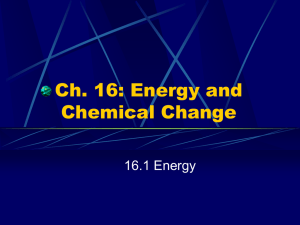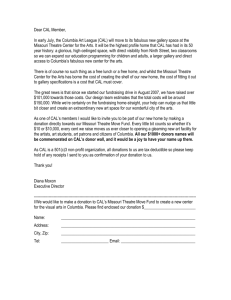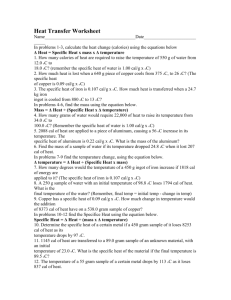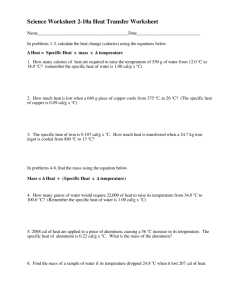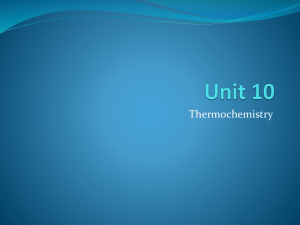CT1b
advertisement
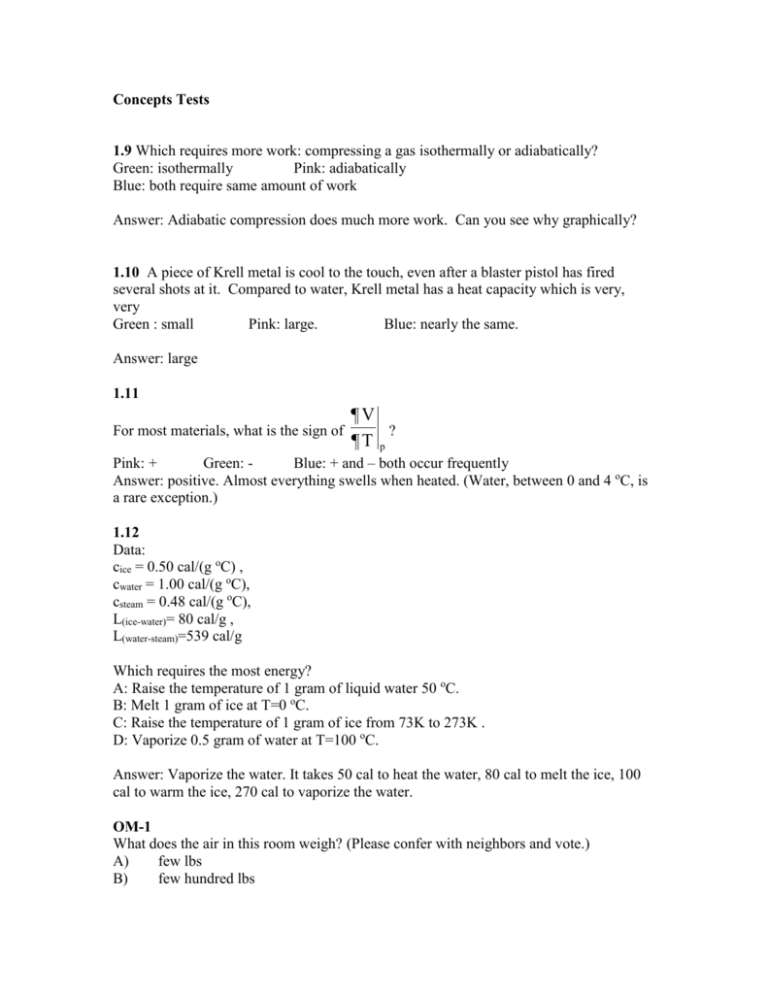
Concepts Tests 1.9 Which requires more work: compressing a gas isothermally or adiabatically? Green: isothermally Pink: adiabatically Blue: both require same amount of work Answer: Adiabatic compression does much more work. Can you see why graphically? 1.10 A piece of Krell metal is cool to the touch, even after a blaster pistol has fired several shots at it. Compared to water, Krell metal has a heat capacity which is very, very Green : small Pink: large. Blue: nearly the same. Answer: large 1.11 For most materials, what is the sign of ¶V ? ¶T p Pink: + Green: Blue: + and – both occur frequently Answer: positive. Almost everything swells when heated. (Water, between 0 and 4 oC, is a rare exception.) 1.12 Data: cice = 0.50 cal/(g oC) , cwater = 1.00 cal/(g oC), csteam = 0.48 cal/(g oC), L(ice-water)= 80 cal/g , L(water-steam)=539 cal/g Which requires the most energy? A: Raise the temperature of 1 gram of liquid water 50 oC. B: Melt 1 gram of ice at T=0 oC. C: Raise the temperature of 1 gram of ice from 73K to 273K . D: Vaporize 0.5 gram of water at T=100 oC. Answer: Vaporize the water. It takes 50 cal to heat the water, 80 cal to melt the ice, 100 cal to warm the ice, 270 cal to vaporize the water. OM-1 What does the air in this room weigh? (Please confer with neighbors and vote.) A) few lbs B) few hundred lbs C) few thousand lbs D) more than 20,000 lbs Answer: A few hundred pounds. Air has a density of roughly 1-2 kg/m3 (1/1000 that of water). A typical room has a few hundred cubic meters of air. 1.13 What happens to the mean free path l in a gas sample, if the pressure is doubled, at constant temperature? A: l increases B: l decreases C: l remains the same Answer: mean free path decreases. Since N/V = p/(kT), increasing p, at contant T, means increasing N/V = n = number density (n does not mean nbr of moles here!). Mean free path l = 1/n 1.14 What happens to the mean free path l in a gas sample, if the temperature is increased at constant volume? A: l increases B: l decreases C: l remains the same Answer: l remains the same. Neither number of particles N, nor volume V changes, so number density n = N/V does not change. 1.15 Does the random walk formula L rms = N l depend on the dimensionality of the walker? 1D (random walk back and forth along the x-axis) vs. 2D(walk in the plane) vs. 3D (walk in space) Is the formula different for the different cases? A: No, same formula used for any dimension B: Yes, must use different formula for the different cases. Answer: No, same formula regardless of dimension. 1.16 The diameter of a room is doubled (at constant temperature, constant pressure). What happens to the (average) time required for a molecule to diffuse across the container? A: time doubles B: time increases by factor of 4 C: some other answer Answer: time increases by factor of 4 1.17 The “cool-down time” of a building is how long it takes for the temperature difference between inside and outside to fall to (1/e) of its initial value once the heat goes off. (Assume it’s winter.) Mean power P = (energy change U)/(time t) so t = U/P. The energy content of a building is proportional to its volume (L3). The power lost through walls is proportional to …(?) Consider a cubical building. If the edge length L is decreased by a factor of 2. What happens to the cool-down time? L/2 L A) increases by 2 (takes longer to cool) B) decreases by 2 (cools faster) C) decreases by 4 D) increases by 4 E) some other answer Answer: decreases by 2 Power through walls is proportional to area L2. D U L3 Dt = µ 2µL P L Small dogs shiver when wet, while big dog frolic. 1.18. The thickness of the insulation in the walls/roof of a building is doubled. What happens to the cool-down time? A) increases by 2 B) increases by 4 C) increases by 8 D) increases by 16 E) some other answer Answer: The power (rate of heat flow) through a wall is proportional to the temperature DT gradient . If the wall thickness x doubles, the gradient is halved, so power P is Dx halved. The cool-down time Dt = DU P doubles.







